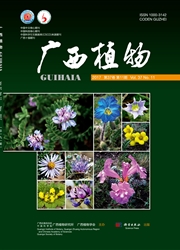

 中文摘要:
中文摘要:
黄杉为国家Ⅱ级保护植物,是我国特有的第三纪孑遗的珍贵树种,主要分布在我国亚热带的中山地带。采用Braun-Blanquet的植物社会学调查方法并结合典型样方法对七姊妹山自然保护区的原生黄杉群落进行调查,并对其群落特征进行了分析。结果表明:在2300 m~2的调查样地,共有维管束植物52种,隶属24科38属,群落物种组成主要以杜鹃花科、豆科、五加科、壳斗科等种类为主;群落生活型组成分析显示,该黄杉群落高位芽植物占绝对优势,高位芽植物、地面芽植物占比分别为76.9%、13.5%,地上芽和地下芽植物较少,植物的生活型谱大致呈"L"型;群落重要值分析表明,黄杉重要值为53.6,占较大优势,是群落建群种,乌冈栎、石韦分别是灌木层及草本层的优势种,其重要值分别为24.0、54.8;该黄杉群落物种多样性指数整体较低,除均匀度指数外,优势度指数、多样性指数、丰富度指数总体表现出灌木层〉乔木层〉草本层,上坡〉山脊的规律;种群年龄结构分析表明,七姊妹山自然保护区黄杉种群年龄结构呈"L"型分布,属于增长型种群,在一定时间内,表明黄杉仍为该群落的优势种群,林窗的出现使该黄杉群落保持持续更新。
 英文摘要:
英文摘要:
Pseudotsuga sinensis is the second-class state protected plant,it is China’s unique tertiary relict precious species and mainly distributed in subtropical mid-mountain zone. In order to better protect the remnant and endangered P. sinensis,we investigated original P. sinensis forests in Qizimei Mountains Nature Reserve using Braun-Blanquet phytosociological and typical plots methods and analyzed their community characteristics. The results showed that the P.sinensis community contained 52 vascular plants belonging to 24 families and 38 genera in 2300 m~2 sample plots. The P. sinensis community was mainly composed of Ericaceae,Leguminosae,Aaliaceae,Fagaceae species and so on. Moreover,the life form composition of the P. sinensis community revealed that Phaenerophytes had an absolute dominance,besides,Phaenerophytes and Hemicryptophytes accounted for 76.9%,13.5% respectively. Chamaephytes and Geophytes were fewer plants,occupied small proportion. Therefore,the life form spectrum was roughly "L"type. The analysis of community importance values showed that the P. sinensis was absolutely dominant in the tree layer and its importance value was 53.6,and it was constructive species in the community. Moreover,the Quercus phillyreoides and Pyrrosia lingua were the dominant species in shrub layer and herb layer, and their importance values were 24. 0,54. 8respectively. Based on our analysis,we found that the species diversities indexes of the Pseudotsuga sinensis community were low in general. In addition to species evenness index,species dominance index,species diversity index and species richness index had the same patterns: species diversity index in shrub layer was the highest,the tree layer was the second,and the herb layer was the lowest. Based on the topographical conditions,we knew that the species diversity index exhibited that the upper slopes was greater than the ridges regularly. Population age structure showed that the P. sinensis had an L-shaped distribution,which implied the community of P. sinensis w
 同期刊论文项目
同期刊论文项目
 同项目期刊论文
同项目期刊论文
 期刊信息
期刊信息
